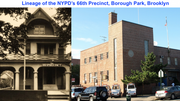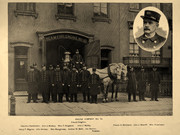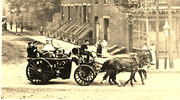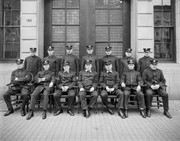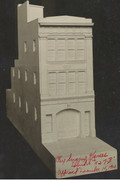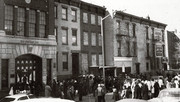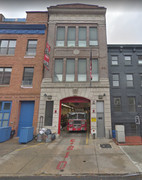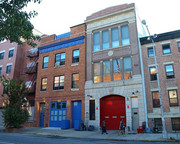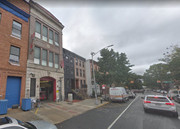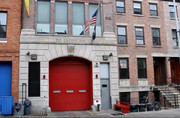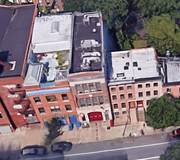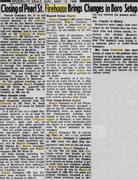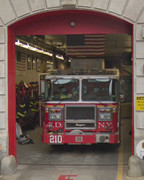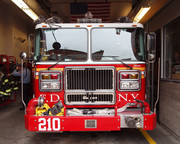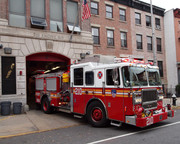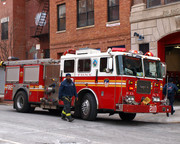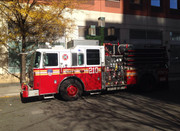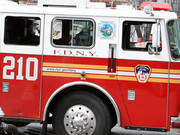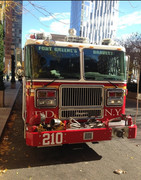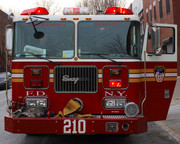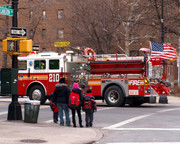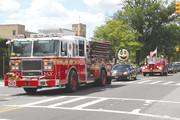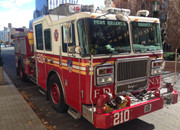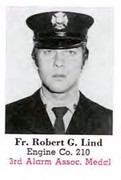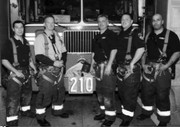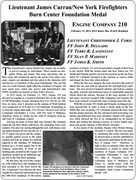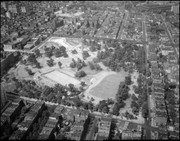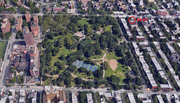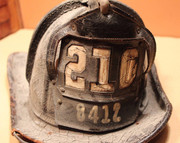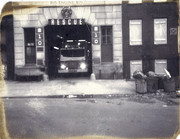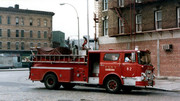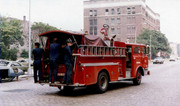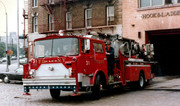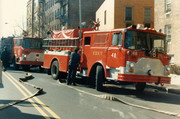Supervising Engineer Unit 1 Welfare Island
DISBANDED
Supervising Engineer Unit 2 Pier A
DISBANDED
Supervising Engineer Unit 1 organized 1889
Supervising Engineer Unit 1 disbanded 1960
Supervising Engineer Unit 1 - one section located at Engine 5 and second section located at Rescue 2 in 1939 - later moved to Welfare Island
Supervising Engineer Unit 1 was responsible to determine if apparatus and equipment operated effectively. Also supervised special units without officers at multiple alarms (water towers, searchlight units). It responded to 2nd alarms in Manhattan, Brooklyn, Queens and the Bronx and to 3rd alarms in Staten Island. Supervising Engineer Unit 1 was disbanded in 1960.
Supervising Engineer Unit 2 was organized to determine if fireboats and marine equipment operated effectively. Supervising Engineer Unit 2 operated from
the Marine Repair Shop, Engine 86, and later from Pier A. Supervising Engineer Unit 2 was disbanded in 1959.
Supervising Engineer Unit 1 firehouse (former quarters Engine 49) Welfare Island
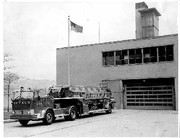
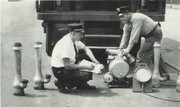
Supervising Engineer Unit 1 - FDNY Organization Chart 1959 - Special Unit:
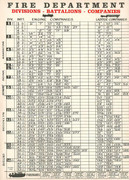

Supervising Engineer Unit 1 - Description 1957:
Fire Engineering 8/1/1957
Specialization Keynotes Operations of Supervising Engineer Units - 08/01/1957
By THOMAS D. RYAN CAPTAIN, Supervising Engineer
Specialization Keynotes Operations of Supervising Engineer Units
A detailed analysis and description of the duties and operations of New York's Supervising Engineer Company No. 1

INDUSTRY AND MANAGEMENT have recognized the fact that this is an era of specialization and from the standpoint of efficiency, it is wise policy on their part to endeavor to find the right man for the right job. Furthermore, the quality and quantity of this individual?s work output will be considerably enhanced if he has a working knowledge of those operations related, directly or indirectly, with his specialty. In short, for each special job operation they seek the man who possesses specialized skill, and in addition, what is generally termed ?a well-rounded background.?
Of late, progressive fire officials in increasing numbers have recognized this cardinal principle in their selection of men for specialized activities or units. No longer is proficiency in automotive mechanics the sole criteria in choosing driver-operators of pumpers (variously called motor and pump operators). While possession of such automotive knowledge and skill is a definite asset, candidate selection must also take into account such qualifications as a working knowledge of practical hydraulics, pump theory and operation, skill at the wheel and, because of the burden of the operator?s heavy responsibilities, correct driving attitudes and habits.
Applying this thought to another branch of the fire service, men assigned to rescue squads need far more than a working knowledge of first aid. The situations they encounter prescribe the use of cutting torches, heavy-duty rescue equipment and a variety of special tools as well as resuscitators, masks, etc.
Today we find a greater number of specialist personnel and specialized units being established whose duty, regardless of rank, is mainly supervisory. It is with one such group?that of Supervising Engineer Company No. 1 of the New York City Fire Department?that this article deals.
Because of its accomplishments, the work load of the unit has constantly been expanded, its quota of personnel increased and its physical facilities improved during recent years under the leadership of the department?s progressive fire commissioner, Edward F. Cavanagh, Jr., and its far-sighted chief of department, Edward Connors. The unit itself is incorporated in the Division of Firefighting Equipment which, in turn, is commanded by Chief Supervising Engineer Harry M. Irwin.
Organization and background:
The department?s records disclose that the unit was originally established some 67 years ago, on June 6, 1889 to be exact, when Department Order No. 7 designated two members as supervisory engineers with the duty of responding to all third alarms ?to supervise the working of all engines at fires and to give such instructions as they may deem necessary for proper handling as well as for best delivery of water.? These original men in the unit were informed that ?cannel coal of the purest grade will not clinker on grate bars, when used in the furnace of the boiler.? They were further instructed to make special mention in their reports of all cases ?where the coal is found to clinker, stating to what extent and its effect on the steaming of the boiler.? Stemming from such unique and antiquated responsibilities, the unit?s fire operations and other duties have been expanded to such an extent that today it occupies a key post in the over-all plan of the department.
At present the staff of Supervising Engineer Company No. 1 comprises 16 members, including one captain, four lieutenants and 11 firemen. Unit No. 2 in the Marine Division, is mainly concerned with repairs to our fireboats and is not assigned to respond to alarms, although it may be called in an emergency.
Actual engineering background on a formal basis is not a prerequisite for members in order to be assigned to Unit 1. Instead, the emphasis is placed on ability in practical situations, with the men possessing qualifications not commonly developed in the firefighting personnel.
First, its members must be endowed with mechanical aptitude above the average and more than ordinary knowledge of physics, particularly in the field of applied mechanics. Considerable and varied backgrounds in firefighting are desirable assets which are gained through assignments to different fire stations, including both engine and ladder companies. While a definite period of experience cannot be stipulated, since some men mature more quickly than others, it is preferable that applicants have several years behind them, in order to face up to some of the situations the unit encounters. Present policy dictates that men should not be transferred into the unit until their backgrounds and records have been examined and they have had an observation period of several months to determine whether or not they measure up to the required standards, and whether they adapt themselves to the wide variety of work and the heavy workloads.
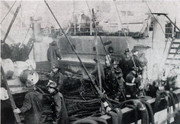
Because of the highly specialized nature of the work, its officer personnel for the most part have graduated from the rank of fireman in the unit. It is manifestly unfair to take an officer whose experience has been mainly in one specific company in the department and expect him to show immediate familiarity with all types of apparatus and equipment. In the New York Fire Department there are over 800 pieces of apparatus including 129 different kinds. Even confining this topic to aerial trucks and pumpers, we find over 25 different types or makes.
In order to keep ?on its toes? and overcome the element of forgetfulness, besides the field training program, mentioned later on, a daily drill session is held, using the apparatus in the shops for repairs. The unit is quartered in the same building as the shops of the Division of Repairs and Transportation.
To supplement their broad practical backgrounds, each officer of the unit has been given specialized training in methods of teaching, with particular stress on the proper conduct of classes and drills. Besides standardizing the methods of instruction and the operation of each piece of equipment, officer personnel have attended various outside fire schools and conferences.

In addition to instructional and maintenance manuals covering all pieces of fire apparatus presently in service in the department which are contained in the office of the supervising engineer, the unit makes fullest use of the department?s extensive reference library located in the same building. All published data bearing upon the manufacture, maintenance and operation of the department?s varied equipment is studied for new and progressive ideas which may be incorporated in the unit?s instructional material.
Unit has many duties:
While appropriately and primarily the unit is concerned with apparatus and water supply, the duties of its staff at a fire or emergency may range from such ordinary assignment as giving a progress report over the radio for the chief in charge, to assisting a company or commanding a group in holding a difficult position.
As previously mentioned the Supervising Engineer Unit covers the entire city on: (a) Second or greater alarms; (b) wherever special apparatus is used; (c) all unusual incidents.
Its members first report to the chief in charge with information on the water supply, as follows: (a) The sizes of water mains being used; (b) nearby larger mains, if any; (c) hydrant pressures, both static and residual; (d) other unusual factors affecting operations. With this information at hand, it is frequently possible to spot pumpers more intelligently in order to take advantage of larger size or cross-connected mains and thereby avoid what is termed ?running away from the water.? These factors pertaining to water supply are, of course, ascertained on approach to the fire scene. Apropos of this, members have through experience become familiar with problems which are peculiar to certain sections of this city and so in many cases are able to suggest solutions to circumvent them. As a concrete example, following the disastrous 11-alarm fire in the Williamsburg section of Brooklyn in 1955, it was found that, although Brooklyn and New York were consolidated nearly 60 years ago, the water mains of the adjoining boroughs of Queens and Brooklyn had never been cross-connected at this point. As a result, the tremendous flow of water through the single Brooklyn feed main increased friction losses to a point where pumpers were operating near a zero intake pressure. In the event of a similar fire in this area, it would have been necessary to relay water from one water main system across the borough boundary line to the other mains. Following the unit?s investigation, a large specially valved cross connection has been installed by the Department of Water Supply, Gas and Electricity at a point in this area where the two boroughs join. Thus, in the event of a serious fire, water can readily be diverted across the boundary line.

In addition, maps of the layouts of mains in certain parts of the city are provided by city agencies and carried on the unit?s apparatus. These are consulted while responding, particularly if the fire is gaining headway, as gleaned from the radio progress reports. Because of such foreknowledge, it was practicable at the nine-alarm lumber yard fire in Jamaica, Queens, to locate pumpers on a large feed main some two blocks distant from the fire and more effectively supply water to the pumpers nearer the fire.
At fires a continual check is maintained on available pressures on the mains and, as indicated, pumpers are either positioned on other mains of greater capacity or emergency crews of the two city water agencies are called to open up additional valves or to cut in additional pumps to build up lagging pressures.
A quick analysis of all these factors affecting water supply is given to the ranking officer at the fire when reporting in, and at least one member of the unit remains nearby for consultation in assigning incoming companies to the most advantageous positions for their apparatus, indicating which pumper should be used for the shortest stretch and most efficient operation, and coordinating all companies involved in any relay operations. The other members of the unit generally split up in order to make the rounds quickly and check all working apparatus.
Checking apparatus:
In the inspection of each piece of apparatus, all major points of its operation are carefully covered, including:
The motor?generally through observation of its dash controls
Temperatures: Proper operating range, correct usage of direct or indirect cooling systems
Ignition systems: Generator, alternator, rectifier, battery, proper usage of selector switches for ignition and accessories
Oil pressures: As indication of trouble in motor lubrication system
Gas and oil: Sufficient for present and anticipated needs
Motor speeds: Tachometer reading indicates whether or not motor is exceeding the speed range wherein it delivers its maximum horsepower output
The fire pumps?The inspection starts in the cab to see that road drive is disengaged and the transmission stick is locked in the proper gear. It then encompasses:
Proper position of stage valves, A and B valves, series-parallel valve, cross-over valve or whatever term is used
Churn valve: Loss of efficiency is prevented by its correct usage
Governor or relief valve: Must be working properly and correctly set
Pump pressures?Operating pressures are checked in order to prevent injury to personnel and provide most efficient streams.
Stretching of lines?Efforts are directed towards preventing laying of hose unnecessarily. Where possible, the apparatus is used in making the stretch.
Placing of apparatus?All apparatus must be advantageously positioned for immediate or possible usage. If it is definitely not to be used, it is removed out of the path of traffic.
Drafting operations:
The technicalities of drafting operations, especially when of considerable magnitude, with falling tides, foul water, etc., may test the resources and skill of any municipal fire force. At such times close and efficient supervision of operations is essential.
Standpipe, sprinkler, yard hydrant and foam supply systems:
Because of their technical nature and the magnitude and complexity of involvement, the job of insuring safe and effective operation of such systems is generally delegated to the supervising engineering unit. A notable example was the situation created when a plane crashed into the 79th floor of the Empire State Building, causing a break in the standpipe riser below the fire floor. The break was quickly discovered and that section of the riser isolated and water by-passed around the break, largely through the efforts of the officer in charge of the supervising engineer unit at the time.
Before leaving the scene of any fire, a final cheek is made by unit personnel of the apparatus in operation. To prevent unnecessary tie-up of vehicular traffic, a survey is made of hose lines and where advisable, these as well as pumpers, are shifted to open up thoroughfares. A final report is then made to the chief in charge and the unit returns to quarters.
Dewatering:
Every metropolitan fire department is called upon at some time to assist in dewatering buildings, underpasses, etc., with resultant complications which may imperil men or apparatus. This task of supervising such details usually falls to the lot of the supervising unit. Such was the case when New York City?s fire commissioner and chief of department heeded the call for assistance from flood stricken Danbury, Conn., a year ago. In this emergency the unit?s personnel supervised the mechanics of the entire lengthy dewatering operation.
Probably the most protracted and extensive dewatering job ever undertaken by a fire department was that involving the Wanamaker Building and Manhattan?s subways a year ago. The supervising engineering unit was up to its Plimsoll mark, literally and figuratively, in this operation which saw the removal of over 81 million gallons of water and the inundated subways restored to service.
Building collapse:
Any building collapse, whether as a result of fire, explosion or other causes, usually involves technical problems of coping with gas, water and electricity, and their possible bearing upon the rescue of persons. Here, also, the unit may be called to utilize its special facilities and talents. This was demonstrated in the memorable Amsterdam Avenue tenement collapse of 1947 which took 37 lives. The unit?s personnel operated with members of fire and other rescue units for many hours.
Special post-fire tests:
Frequently explosive fires and other emergencies call for post emergency tests and experiments, such as checking on water flow and injuries to standpipe and related extinguishing systems. This is another field in which tire supervising engineers may be called in. This occurred following the Holland Tunnel fire of some years ago, when hydrostatic and flow tests were run on the tunnel?s standpipe system. As a result of disclosures, a new operating procedure was formulated to fight any future similar fires in the shaft.
Many miscellaneous tasks:
Over the years the unit has functioned in many other activities, including such details as testing various departmental equipment and new inventions; directing various relay operations; filling a swimming pool in the upper stories of a settlement house; restoring heating plants to operation; isolating breaks in water supply systems and assisting in bridging such breaks; participating in Civil Defense operations, etc.
In looking back over the number and variety of the tasks performed, one recalls the statement of a top official of the department in discussing the unit?s expanding work load; ?They?re jacks of all trades?and masters of them, too.?
Supervising Engineer Unit 1 LODD:
FF PAUL R. CADY JANUARY 13, 1960


FF Paul R. Cady died January 13, 1960 as a result of injuries sustained in the line of duty January 10, 1960. FF Cady was a 29 year veteran.
RIP. Never forget.

